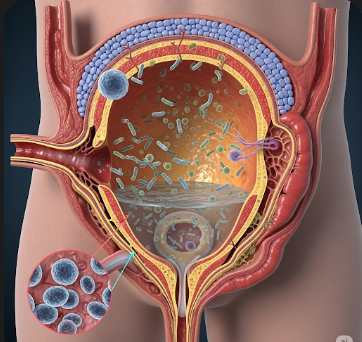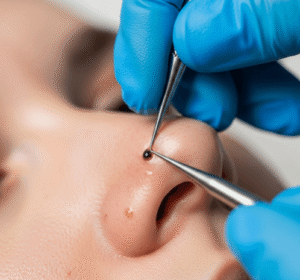Overview
A bladder infection, medically referred to as cystitis, is a type of urinary tract infection (UTI) that primarily affects the bladder. It occurs when bacteria enter the urinary tract and multiply, causing inflammation of the bladder lining. Bladder infections are common in women but can also affect men, children, and the elderly.
In Korea, bladder infections are diagnosed and treated promptly in clinics and hospitals with access to urine testing, imaging, and effective antibiotics. Early intervention prevents complications such as kidney infections and recurrent UTIs. Korean healthcare emphasizes patient education on prevention, lifestyle modifications, and adherence to treatment protocols.
What is a Bladder Infection?
Bladder infection is a bacterial infection that inflames the bladder wall. Escherichia coli (E. coli), a bacterium commonly found in the intestines, is responsible for most cases. The infection may be:
- Acute: Sudden onset with intense symptoms
- Chronic or recurrent: Persistent or frequently recurring infections, often related to underlying medical conditions
Bladder infections are part of a broader urinary tract infection spectrum, which can affect the urethra (urethritis) or kidneys (pyelonephritis). Left untreated, a bladder infection can spread and cause more severe systemic infections.
Symptoms
Bladder infections can cause a variety of symptoms, often sudden in onset:
- Frequent urination: Needing to urinate more often than usual
- Urgency: Sudden and strong urge to urinate
- Painful urination (dysuria): Burning or stinging sensation during urination
- Cloudy or strong-smelling urine
- Hematuria: Presence of blood in the urine
- Lower abdominal or pelvic discomfort
- Mild fever or fatigue in some cases
In elderly patients, symptoms may be subtle, sometimes presenting only as confusion or behavioral changes.
Causes
Bladder infections result from bacterial invasion and colonization in the bladder:
- Bacterial contamination: Primarily E. coli from the gastrointestinal tract
- Sexual activity: Facilitates bacterial entry into the urethra, increasing infection risk
- Urinary retention: Incomplete bladder emptying can promote bacterial growth
- Catheterization: Long-term or improper catheter use increases infection risk
- Structural abnormalities: Kidney stones, enlarged prostate, or bladder diverticula
- Weakened immune system: Diabetes or other chronic illnesses increase susceptibility
Risk Factors
- Female gender, due to shorter urethra and closer proximity to the anus
- Sexual activity, especially new or frequent partners
- Use of spermicides or diaphragms
- Postmenopausal changes reducing estrogen and altering urinary tract defenses
- Urinary tract abnormalities or obstructions
- Diabetes or immune system deficiencies
- Catheter use or recent urinary tract instrumentation
Complications
If left untreated, bladder infections can lead to serious complications:
- Kidney infection (pyelonephritis): Pain, fever, nausea, and risk of kidney damage
- Recurrent infections: Multiple episodes leading to chronic inflammation
- Sepsis: Rare but potentially life-threatening if infection spreads to the bloodstream
- Bladder damage: Long-term inflammation causing scarring and reduced bladder function
- Pregnancy complications: Preterm labor or low birth weight in pregnant women
Prevention
Preventive strategies focus on reducing bacterial entry and supporting bladder health:
- Hydration: Drink plenty of water to flush bacteria from the urinary tract
- Proper hygiene: Wipe from front to back to prevent bacterial transfer
- Frequent urination: Avoid holding urine for long periods
- Urinate after sexual activity: Helps flush bacteria from the urethra
- Avoid irritants: Limit use of spermicides, perfumed soaps, and harsh hygiene products
- Cranberry or D-mannose supplements: May reduce bacterial adherence in some individuals
- Medical follow-up: Regular monitoring for recurrent infections or underlying conditions
Treatment Options in Korea
Diagnosis
In Korea, bladder infections are diagnosed using:
- Urinalysis: Detects bacteria, white blood cells, or red blood cells in urine
- Urine culture: Identifies specific bacteria and determines the most effective antibiotics
- Imaging studies: Ultrasound or CT scans to detect structural abnormalities or complications in recurrent cases
- Cystoscopy: Examines the bladder lining in chronic or complicated cases
Medical Management
- Antibiotics: First-line treatment, with courses varying from 3–7 days depending on severity
- Pain relief: Analgesics or urinary tract-specific medications to reduce discomfort
- Hydration: Encouraged to aid in flushing bacteria from the urinary tract
- Follow-up testing: Ensures complete resolution of infection, particularly in recurrent cases
Supportive Care and Lifestyle Measures
- Maintain good hydration and healthy urinary habits
- Avoid irritants and follow proper hygiene practices
- Manage underlying health conditions such as diabetes or prostate enlargement
- Education on early recognition of symptoms to prevent recurrence
Prognosis
Bladder infections in Korea generally have an excellent prognosis with prompt treatment. Most acute cases resolve within a few days of antibiotics, and patients recover fully. Recurrent infections require careful evaluation and management to prevent complications. With modern diagnostics, effective antibiotics, and preventive strategies, bladder infections rarely lead to severe long-term issues, and patients can maintain normal urinary function and overall health.













